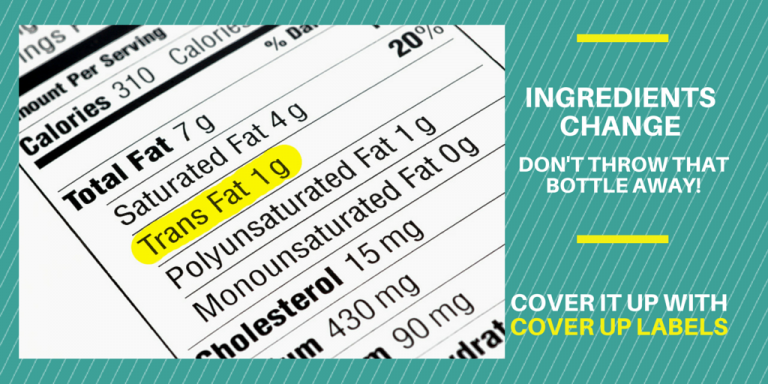
A Short Guide to Cover Up Labels
It’s ok. We all make mistakes. After all, we’re only human.
(Except my cousin Ralph, he never makes mistakes. But I digress).
Chances are, if you are in the business of selling any products, then it’s almost a guarantee that you either needed cover up labels in the past or will need cover up labels in the future.
What’s a cover up label?
If you’ve never heard of cover up labels, the name is self-explanatory: cover up labels are used to cover text or graphics on a preexisting label or product. The cover up label usually has an opaque underside and a strong adhesive which stops customers from seeing the text or graphics that are being covered.
Why might you need a cover up label? I’m glad you asked! Here are a few reasons why you might find yourself in need of cover up labels:
4 Key Reasons you might need a cover up label
- New or updated ingredients – Most consumers would be surprised that there are different standards for listing ingredients in different industries, and that these standards change relatively often. As a result, manufacturers may find themselves with a sudden need to produce new ingredient listings on labels for the same product.
- Errors – Mistakes may come in the form of either the printer or the client. Even with proofing, some of the most common mistakes include:
- Typing or spelling errors
- Missing text (warning statements)
- Incorrect numbers on barcodes for a misread
- UPC assigned to wrong product
- Price Changes – in the event that your label has a printed price which has been changed, you will of course need to change it, thus needing a cover up label.
-
Salvaging Finished Goods – There are times when you may need to change the graphics or text on a product – for example when rebranding, or in a case where the company’s name has changed due to being sold, and you will need to cover the entire label as the logo or brand name have changed.
What to consider when choosing a cover up label
Using a cover up label isn’t as simple as slapping one on your product. There are a number of issues to consider in choosing cover up labels:
- The shape of the area to be covered and the conformability of the product –The shape of the packaging/product that your label will be placed on may limit or restrict your label material options. For example, squeezable tubes require labels that are flexible and can withstand significant force, so that a squeezable film would be required. And if you have a very specific area to cover, you may need to purchase a special tool to cut that exact shape.
- Aesthetically pleasing – When using cover up labels, you must ensure that the new cover up label looks and feels as if it “fits” the product, both visually and tactically. Matching stocks, color, coatings and type fonts and style are all ways to ensure the look and feel of your label are consistent.
- Strong adhesive – if you want to ensure that your label can’t be removed or separated. The type of adhesive necessary will depend on the packaging material, so you should ensure your label producer has samples of your product to provide you test samples.
- Label opacity -If you are covering up an older lower price or net weight, your consumer may find it off-putting if the new label is not in their favor. Or your new UPC may not scan properly if the one underneath is showing through. Opacity issues are particularly of concern when your cover up label stock is white. But have no fear. Opacity concerns can easily be minimized by using materials with black out adhesive; silver-backed, white stock; or even by designing the top label with a solid color reversed out to white text. These are just a few solutions.
- Is it the right option? There are times when it simply doesn’t make sense to print a cover up label. Often, with a clear “no label look” material, a cover up label ruins the effect and is not an option. In cases of a rebranding, it may often make sense to completely replace the label rather than using a cover up label.
Are you in a bit of a sticky situation where cover up labels may be a good solution? Unsure if a cover up label is what’s necessary or if you should just restart the whole process? We can help! Send us a quick email or schedule a free (no hassle, no strings) consultation to discuss your cover up label needs.
